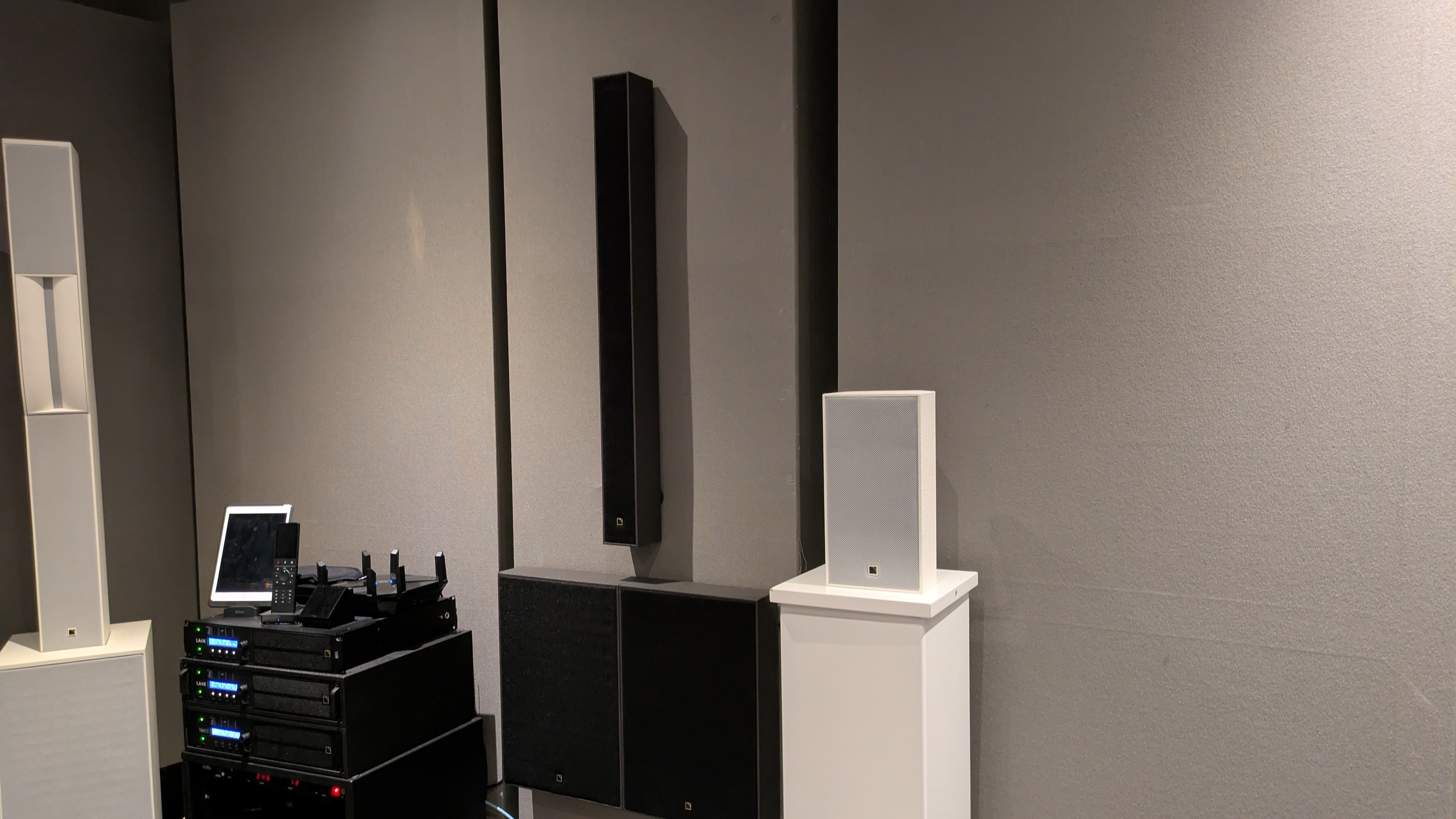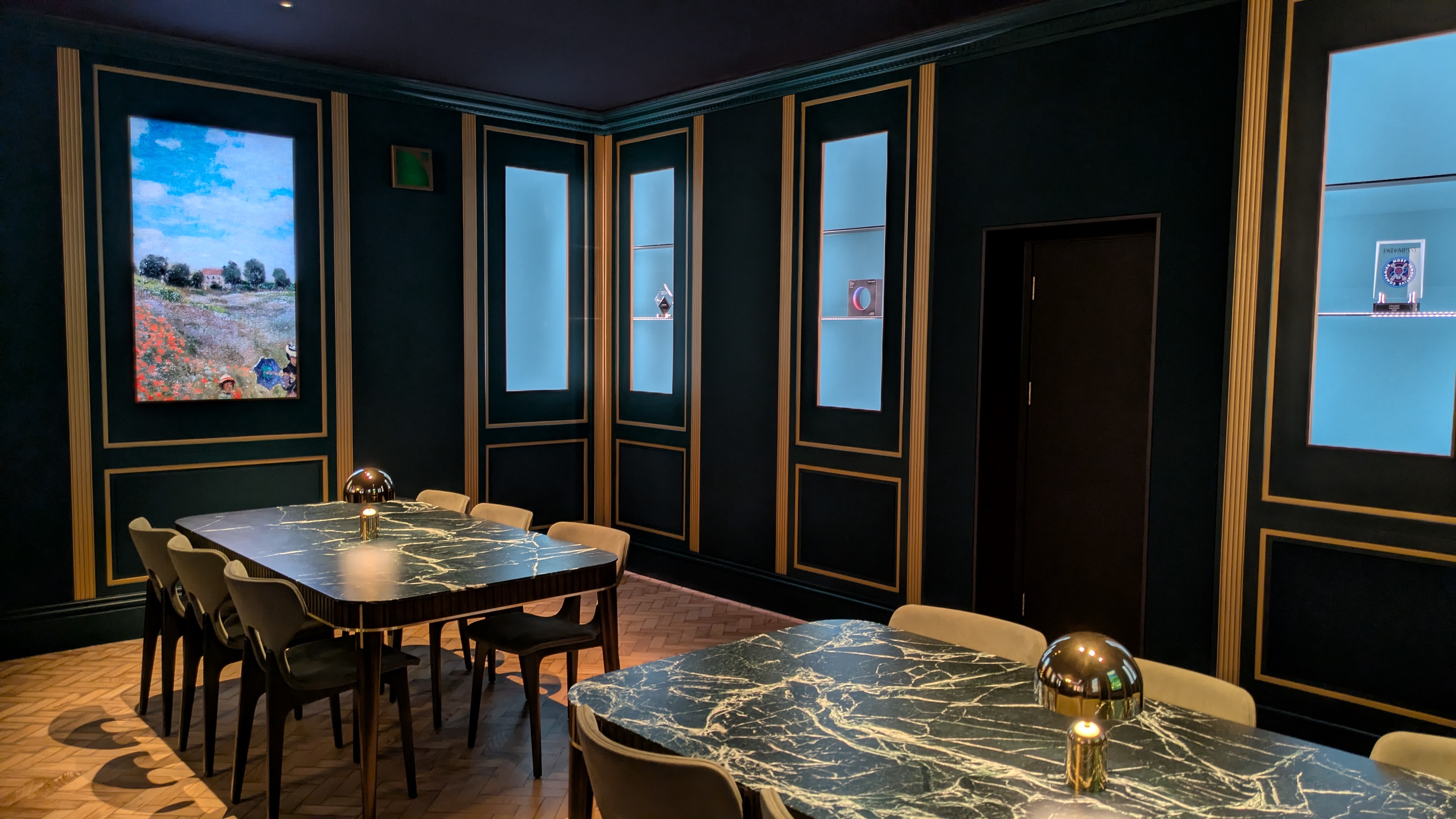I experienced L-Acoustics' HYRISS listening room and it could change home audio as we know it
Audio's future is here

L-Acoustics is a name you may not be familiar with, but it carries serious pedigree in the audio world. If you've ever visited the Hollywood Bowl in Los Angeles, the Alexandra Palace, O2 Brixton Academy, and Eventim Apollo in London, or the Notre Dame Cathedral in Paris to name a small few, you’ll have experienced L-Acoustic’s speakers – most likely the long black stack in a J shape hanging either side of the artist on stage.
L-Acoustics was founded in 1984 after founder Christian Heil, a particle physicist, attended a Pink Floyd concert and decided to combine his field of study with his passion for acoustics. This led in 1992 to L-Acoustics revolutionising the line speaker array concept with its V-DOSC system to better quality and more consistent sound across all frequencies without interference – something vital for live concert settings.
So, it’s no surprise that L-Acoustics has taken what it has done in the professional environment and brought it to the home. I recently got to experience its latest innovation, the Hyperreal Immersive Sound Space (HYRISS) concept. This goes beyond spatial audio formats like Dolby Atmos to reimagine what sound can do altogether, and quite simply, from what I heard it does.
The concept and system

HYRISS at its core is an immersive, 3D network of speakers. Combined with some clever software named Anima, it can transform listening environments to suit any occasion with ease. While Dolby and DTS formats are of course supported, I was told that HYRISS expands vastly on what you’d hear from the best Dolby Atmos soundbars and best home theater systems.
The system I heard in L-Acoustics’ London showroom consisted of a 17.1.12-channel speaker configuration. That .1 refers to the subwoofer or bass channel, but in this room, there wasn’t one subwoofer but 34 of them. These subwoofers, L-Acoustics’ own SB10i models, were in the wall directly underneath the system’s L-Acoustic Soka in-wall speakers, a slim design measuring 4 inches deep and 41 inches high, with two SB10i subwoofers per speaker.
At the very front, underneath a commercial-only Samsung 98-inch OLED display, was an L-Acoustics X8i speaker for the center channel, which also had two SB10i subwoofers underneath, and finally X6i speakers for the height channels. Also in the ceiling were eight microphones (which I’ll talk about later).
The sheer number of speakers in the system was mind-blowing, but what’s important is how they performed, and luckily for me, they delivered.
Get daily insight, inspiration and deals in your inbox
Sign up for breaking news, reviews, opinion, top tech deals, and more.
Unforgettable audio

The first part of my demo was a purely audio demonstration. Within seconds, the entire ambience of the room changed to a ‘deafening’ silence, intending to create a meditative environment. It was as if all the air and excess noise had been sucked out from my ears. Admittedly my mind felt clearer.
Next, a jazz track was played with standard stereo positioning, with all elements coming from the front speakers, which sounded as good as some of the best stereo speakers. But with the simple press of a button via the Anima software, the track gained an entirely new immersive presentation. This was a tech called L-ISA that accurately places instruments to mimic a live performance, and the fuller vocals, warmer bass and overall more dynamic sound.
I was then brought to the middle of the room where I was told I would feel like I was on the “conductor’s podium”. John Williams’ epic score of Harry’s Wondrous World from Harry Potter and the Sorcerer's Stone (Philosopher's Stone outside the US) kicked in from opposite ends of the room and above, encasing me in the bombastic brass section, sweeping strings and gorgeous woodwind – I really did feel like John Williams himself. Again, the effortless transformation of the room was astonishing.
I then requested Tears For Fears’ Everybody Wants To Rule The World – a personal favorite and a track I know well – and was blown away by the system’s clarity and power. Every instrument had excellent detail and was accurately placed, with plenty of room to breathe. As I listened, I was shown how the sound could be easily moved and positioned to suit any situation.
This is one of HYRISS’ main concepts: with the Anima software and a few simple button presses, the sound in the room can be changed. People at the front listening to music? Place the sound there. But then they want to move to the back of the room, the sound can then follow them.
Another impressive feat in my HYRISS demonstration was its ability to change the acoustics of the room, known as Ambience. Remember I mentioned those eight microphones earlier? The Anima program uses them to change the dynamics of the room. In my demonstration, I was in a ‘dry’ room ideal for music playback where there were no echoes. And then one button press later, the room’s acoustics were perfectly suited to a live performance, with the right amount of reverb. There were even options named ‘Cave’, ‘Cathedral’, ‘Theater’ and more.
Bringing the movie theater home

So, HYRISS had more than proven itself for music, but what about movies? First up was the Shallow scene from A Star is Born, the same one used when I saw a reference Dolby Atmos home theater with a Bowers & Wilkins speaker system. As I expected, HYRISS knocked it out of the park.
Lady Gaga’s powerful and dynamic vocals were given breathing room, but all the instruments within the song were also clearly identifiable and spread out in an immersive soundstage. One highlight was how tight everything sounded– no element in the mix over-exerted itself or outstepped its boundaries. Whether it was Gaga’s soaring voice, the pounding drums or the accompanying guitars, everything was loud but under control.
Next up was a favorite of ours at TechRadar: Top Gun Maverick. I got to watch the Mach 10 scene from the movie’s opening, one I regularly use for my testing, and also one that I was shown in Dolby’s own 34-speaker reference theater. Needless to say, I am with this scene and knew what to expect.
Again, HYRISS didn’t disappoint. The thunderous rumble of the Darkstar jet’s engines rattled the room, but the sound was once again tightly controlled. The winds whipping past the cockpit, crystal clear speech and vivid surround and height channel effects made me feel like I was flying Darkstar myself. Everything sounded perfectly balanced with no element exaggerated.
Final thoughts
While the HYRISS demo room I experienced was one of the top examples of what can be achieved with this system, L-Acoustics believes it can be taken to multiple environments – from yachts to live venues and beyond. The company also believes that HYRISS can transform the home environment, with the ability to fit in a space roughly the size of a small apartment.
The system isn’t cheap; the demo room in London for all its speakers and cables cost £320,000 but price will of course vary depending on the space (we've been quoted €3,555 per sq m, which is roughly $3,729 / £2,935 per sq m) as they are bespoke designs. However, it’s tough to argue against just how impressive it is. The versatility of HYRISS and the Anima software could be a game changer for home audio, transforming a space into any sort of listening environment you want it to be with ease. While many home settings won’t be able to capture the impressiveness of the HYRISS room I experienced, even having the potential to come close is nothing short of exciting.
You might also like

James is the TV Hardware Staff Writer at TechRadar. Before joining the team, he worked at a major UK based AV retailer selling TV and audio equipment, where he was either telling customers the difference between OLED and QLED or being wowed by watching a PS5 run on the LG 65G2. When not writing about the latest TV tech, James can be found gaming, reading, watching rugby or coming up with another idea for a novel.